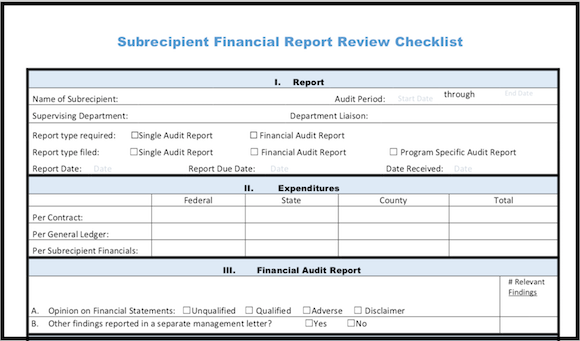|
As mentioned in our last blog post, the Office of Management and Budget’s Uniform Administrative Requirements, Cost Principles, and Audit Requirements for Federal Awards (“Uniform Guidance”) introduced a new requirement for entities that pass federal funds (“pass-through entities”) to non-profit entities or other governments, to monitor those subrecipients.
We provided a list of terms and definitions related to subrecipient monitoring in part one of our subrecipient monitoring mini blog series.
Below, we go over what the Uniform Guidance’s requirement entails, and how to structure your subrecipient monitoring accordingly.
The Uniform Guidance’s requirements became effective in December 2014. Monitoring is required to ensure that subrecipients spend the funds on their designated uses and in accordance with applicable laws and regulations.
If federal funds are passed to individuals or for-profit entities, these are not defined as subrecipients and need not be monitored. The Uniform Guidance requires pass-through entities to provide significant information about each federal grant to its subrecipients to allow them to understand and comply with applicable grant provisions, laws and regulations. It requires pass-through entities to conduct an assessment of each subrecipient in order to “[e]valuate each subrecipient's risk of noncompliance with Federal statutes, regulations, and the terms and conditions of the subaward for purposes of determining the appropriate subrecipient monitoring […]” (Code of Federal Regulations for Grants and Agreements).
Monitoring to be done for each subrecipient must be determined based on the results of this assessment.
The minimum required amount of subrecipient monitoring is:
More elaborate monitoring of risky subrecipients may include training and technical assistance, desk reviews, on-site visits and agreed-upon procedures engagements by a certified public accountant. Although the Uniform Guidance applies only to subrecipients of federal funds, any entity that passes State or local money to subgrantees, or passes federal funds to for-profit entities, would be wise to consider applying the same monitoring as a best practice. Overview of the Subrecipient Monitoring Process:
The Uniform Guidance requirements listed above mean that a pass-through agency needs to:
Other Blog Posts Related to Subrecipient Monitoring:
We have previously provided guidance on subrecipient monitoring in these blog posts (this list will get more extensive as new posts are added on):
Watch for upcoming blog posts about Subrecipient Monitoring, such as:
If you have questions or would like advice on how to implement the recommendations in this blog post in your organization, Kevin is available to answer questions via phone or email at no cost to you:
Kevin Harper, CPA kharper@kevinharpercpa.com (510) 593-503
If you'd like to receive free tips and downloadable tools & templates for your government agency to use, please subscribe to our blog updates here!
Comments
|
The Government Finance and Accounting BlogYour source for government finance insights, resources, and tools.
SEARCH BLOG:
Meet the AuthorKevin W. Harper is a certified public accountant in California. He has decades of audit and consulting experience, entirely in service to local governments. He is committed to helping government entities improve their internal operations and controls. List of free Tools & Resources
Click here to see our full list of resources (templates, checklists, Excel tools & more) – free for your agency to use. Blog Categories
All
Need a Consultation?Stay in Touch! |
Search Across Entire Site:
HELPFUL LINKS:
|
461 2nd Street, #302
San Francisco, CA 94107 (510) 593-5037 KHarper@kevinharpercpa.com |





 RSS Feed
RSS Feed